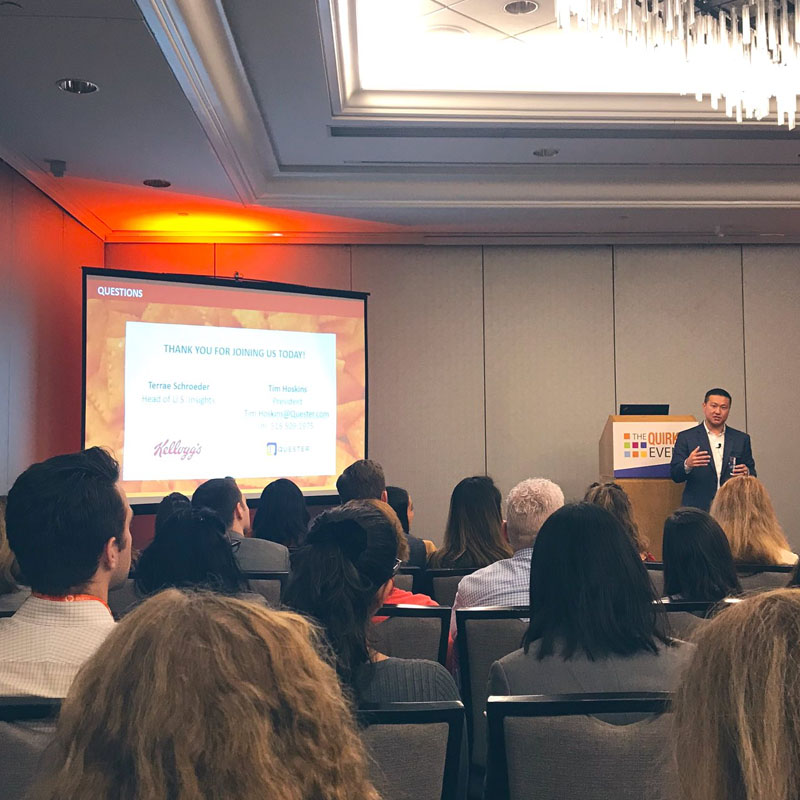 Reading Time: 3 minutes
Reading Time: 3 minutesWith over 1300 attendees, the sold-out event that took place in New York felt like a success to everyone that took part. The friendly atmosphere and interesting sessions made Quirk’s Brooklyn a “must-return” event for anyone wanting to dive deep into market research’s latest developments and trends. As a new member of the market research industry, attending a content rich event like this was an invaluable learning opportunity.
Walking into a room filled with people that you’ve never seen before can be quite intimidating, but I was positively surprised to see that the Quirk’s atmosphere is nothing but welcoming and establishing new contacts really felt effortless (although it did take me a few tries before managing to use the electronic badge successfully!). On top of that what really stuck with me was the variety and quality of the sessions, and although it hasn’t been an easy task, I’ve fished out what I think are “the best of” for this year’s Brooklyn Quirk’s Event:
- Changing the way we think about language
As a passionate professional working in the comms industry, I found this presentation particularly eye-opening. With copywriting being my bread and butter, it was quite shocking to learn that we commonly use just 0.1% of the English vocabulary!
In this session Ben Hookway, CEO at RelativeInsight, explained that in this homogeneous scenario brands need to identify and analyse the (few) differences. By looking at the various nuances in language brands can achieve a much better understanding of consumers and talk to them in a much more effective way.
For example, did you know that 20 year olds “wear” make up, while 50 years old “apply” make up? Or that most people “take pictures”, while professional photographers “shoot images”?
Organisations already have considerable language data (e.g. surveys, social media content, CRM) that can be analysed to understand those hidden trends and differences among their customers. Looking at how consumers communicate can unlock new and precious insights!
2. How to engage Gen Z
For those who don’t know (like me until recently), Gen Z are those born between 1995 and 2010. This is a category of young people who, according to Attest, have a spending power of $143billion and will account for about 40% of consumers in 2020.
So, brands, open your ears! You definitely want to know how to engage and understand this generation…
The three main features that characterise Gen Z are happiness, stress and an addiction to social media that is much more pronounced than Millennials. From Attest’s research, Gen Z also emerges as a loyal group of customers. They will stick with your brand if you offer them good customer service, if your brand reflects their stance on social issues and if you have a strong and positive social media and online presence.
The main reasons for Gen Z to stop purchasing from a certain brand are linked to bad reviews online or a negative news story online. With social media playing such a big part in young people’s lives, they do want brands to communicate with them via social media platforms, especially YouTube and Snapchat. Millennials, on the other hand, prefer WhatsApp and Facebook.
Overall if you know how to communicate with this generation of happy but stressed young adults your brand will be rewarded with long lasting loyalty, so it’s worth a try!
- How to appeal to audiences
Working with the media is a crucial part of our job so it comes as no surprise that the BBC’s presentation was up there with those I didn’t want to miss. In a world where news consumption has been totally disrupted by digital, the media need to evolve and adapt to consumers’ new habits and needs. In the light of this, the BBC’s priority was to grow their digital audience.
In order to do that the BBC identified six news needs that are crucial to understanding how to appeal to consumers. By realising whether the audience wants to be updated, inspired, diverted, educated, kept on trend or be given perspective, media can shape the messaging according to what consumers might find more appealing and are more willing to read.
By understanding these needs editors can inform story choice and treatment. With 12 of the BBC’s newly launched language websites using the news needs framework in the layout of their homepages, reach on digital platforms has started to grow again (+19% in 2019).
My key learning from Quirk’s Brooklyn is that insights teams and brands are increasingly moving towards a consumer-centric strategy, putting a deep understanding of customers’ needs at the centre of their efforts. Whether you’re in the FMCG, media or the retail industry every organisation can and should be focusing on achieving the best understanding of their audience in order to satisfy their needs and be able to tailor their communications, products and offerings in the most effective way.